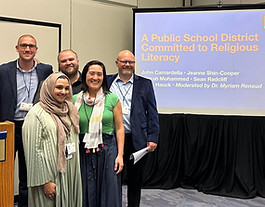Course History


.png)











The Beginning
When I started teaching at Prospect in 2003, I had no idea my career would take the path it has. Like many young teachers, I threw myself into the work — teaching history courses, coaching basketball, and building relationships with students. In 2006, I attended a conference in Bali, Indonesia, titled The Quest for Global Healing, co-hosted by Archbishop Desmond Tutu. I was one of about 500 people from more than 40 countries, surrounded by voices and perspectives I had never encountered before. Those two weeks reshaped my perspective on education and the role it can play in helping students engage thoughtfully with complexity and diversity, and when I returned home, I began exploring ways to bring those lessons into the classroom.
Building the Framework
That summer, I began reaching out to scholars, meeting with local faith leaders, and studying existing materials to build a curriculum that was academically and constitutionally sound. At the time, there were no national standards to guide teachers, so every lesson, resource, and assessment had to be developed from scratch. After years of graduate coursework and multiple rounds of curriculum review, Prospect’s World Religion course was approved in 2009. That milestone marked the beginning of what would grow into one of the school’s most sought-after electives and eventually a model for religious literacy education.
Growth and Refinement
In its early years, the course quickly gained momentum. Within a few years, every section was full, and students often joined a waitlist to enroll. The course struck a chord by offering a space where students could explore the world’s religious traditions with curiosity and respect. At the time, my approach mirrored many high school electives: textbook-driven lessons, content-heavy lectures, and assessments focused on memorization. Students could list essential dates, doctrines, and rituals, but their ability to critically analyze religion as a lived, dynamic force was limited. Even so, those early years revealed just how eager students were for deeper conversations about identity, meaning, and belief, and they highlighted the need for a shift in pedagogy.
A Pedagogical Shift
That shift began during my collaboration with Dr. Diane Moore at Harvard Divinity School’s Religion and Public Life program and Benjamin Marcus at the Freedom Forum in Washington, D.C. The C3 Framework’s Religious Studies Companion Document was published in June 2017, and just a few weeks later, I spent a week in Cambridge with Dr. Moore and her team. There, I immersed myself in the Cultural Studies Method, an approach that emphasizes that religions are internally diverse, shaped by culture, and constantly evolving. What I learned was both humbling and energizing: I needed to start over. Over the next three years, I rewrote the curriculum from the ground up. I redesigned every assessment to ensure that students weren’t just learning about religion, but learning how to think critically about the ways religion operates in the world. This transformation reshaped the classroom. Students approached discussions with deeper curiosity, sharper questions, and a richer understanding of what it means to engage across lines of difference.
National Impact and Recognition
As the course matured, its impact began to extend well beyond Prospect. One hundred and forty seniors now enroll in the class each year, earning dual credit through Eastern Illinois University. Along the way, the course has been featured at national conferences, in publications, and in professional networks committed to advancing religious literacy in education. In 2021–2022, I took a sabbatical to pursue a master’s degree at Harvard Divinity School to deepen my understanding of how religion intersects with identity and public life. Since returning, I’ve had the privilege of sharing Prospect’s work at the U.S. Department of Education’s “Free to Learn” conference in Washington, D.C., and at the Parliament of the World’s Religions in Chicago — humbling reminders of the importance of this work and the responsibility to share what we’ve learned with others.
Looking Forward
Today, our College World Religion course at Prospect is more than an elective — it’s a nationally recognized model for education. Each year, seniors engage in a curriculum that challenges them to think critically, listen deeply, and navigate the complexities of our religiously diverse world with empathy and respect. Students leave not only with a stronger academic understanding of religion but also with practical skills that they carry into college, the workplace, and their communities. Alums often share stories of how this class helped them interact more thoughtfully with patients in hospitals, clients in businesses, and peers in universities, demonstrating the far-reaching and meaningful impact of religious literacy. Looking ahead, my focus will always be on our students at Prospect, as well as on sharing the work we’ve accomplished through partnerships with school districts, universities, and organizations across the country. Whether it’s teacher training, district consulting, or graduate-level instruction, the mission remains the same: to create spaces where understanding is valued over agreement, and where students can bring their full selves to the conversation.

